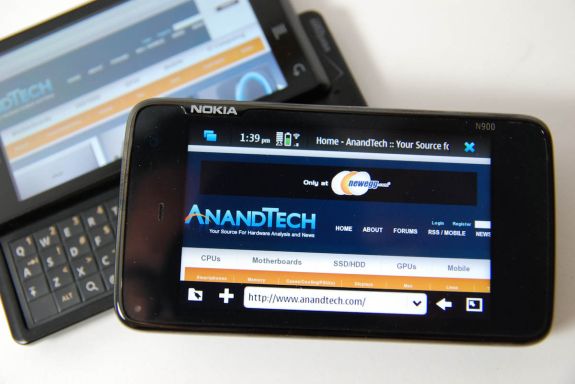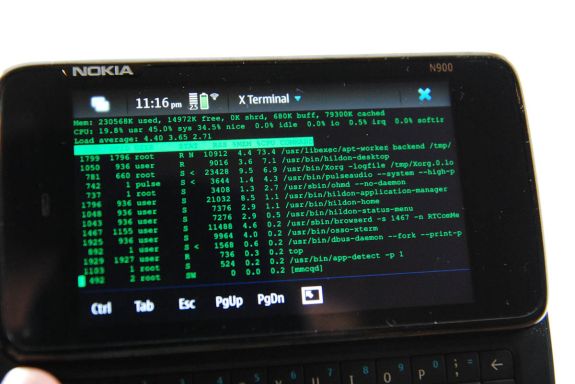Two OMAP 3430 Phones: Nokia N900 and Motorola Droid
by Brian Klug on June 10, 2010 9:29 PM EST- Posted in
- Smartphones
- N900
- Maemo
- Motorola Droid
- Droid
- MeeGo
- Android
- Mobile
Conclusions
We've revisited two phones running the same SoC, each a bit over halfway into their product life cycles. It's an interesting perspective that this gives us, as they're no longer the latest and greatest, but still far above average, and a ways from being obsolete.
From a physical perspective, the Motorola Droid remains the flagship of Android phones that come with a hardware keyboard - a feature that enthusiasts and casual users alike still identify as hugely important. If having a hardware keyboard is important to you, the Motorola Droid is almost the only option out there with a modern ARMv7 CPU.
Even though Motorola's summer refresh is looming - likely bringing along the Motorola Droid 2 and Motorola Droid Xtreme - the phone that launched Android 2.0 will still get an update to Android 2.2 'Froyo,' and likely be offered at a discount price as it continues its life cycle. Already, Verizon is offering buy one get one free on the device. In fact, although many expected Motorola Droid sales to slow down significantly after the HTC Incredible's launch, sales continue to shore up supply, with Motorola's Sanjay Jha making note of device shortages similar to the HTC Incredible's due to demand.
Motorola's made support for its current Droid an obvious priority, as we've seen the device get multitouch in the browser, maps, and gallery, with Android 2.1 among other important features. From a performance perspective, the Motorola Droid's 550 MHz Cortex A8 simply isn't a match for the 1 GHz A8 in Snapdragon's Scorpion CPU - but the Motorola Droid's GPU is faster. The OMAP 3430 still has a lot of life in it waiting for overclockers - in fact, many already do. From a battery life perspective, call time on the Motorola Droid is absurdly long compared to other smartphones at 8.13 hours. In spite of the looming Droid 2 and Xtreme, the original Droid is a sound choice to make if you're on Verizon and absolutely need a hardware keyboard. Though we didn't test it - I would expect much of the same from the handset's GSM cousin - the Motorola Milestone.
When I sat down to tackle the N900, I was hugely excited because of how much potential Maemo still has as it evolves into MeeGo. A month later, I still feel the same way - like I've explored maybe 10% of the platform's real depth. There's something to be said for how truly and completely open Nokia's approach is compared to platforms like Android and iOS. For as big on 'open' as these latter two platforms advertise being, it's refreshingly mindblowing to see Nokia offering instructions on how to get superuser access on their own handset, on their own support website. Contrast that to iOS or Android where one has jailbreak or 'root', respectively, to do things the platform creators don't intend. To that end, I find it incredibly depressing when the Linux chief architect himself, Linus Torvalds, (who is notably Finnish, same as Nokia) embraces Android over Maemo. It's the difference between a platform that lets you fire up a preinstalled X-Term and apt-get install away versus one that doesn't. While that's not really an end-user feature that any handset maker will tout, it's telling about platform philosophy.















68 Comments
View All Comments
Wadzii22 - Friday, June 11, 2010 - link
Out of curiosity I ran linpack and Benchmark pi on my droid that's oc'd to 1ghzmy benchmark pi score was 1280 and linpack gives me 17.24 mflops
strikeback03 - Friday, June 11, 2010 - link
Did you run them stock? As those numbers seem to be a ~4x improvement over what is shown here, which seems odd given the ~2x increase in clockspeed.Wadzii22 - Wednesday, June 16, 2010 - link
with the phone completely stock my scores were basically the same as whats in the original article.jamyryals - Friday, June 11, 2010 - link
Please continue this type of in depth comparison with current and future hardware. PC hardware is all well and good, but it's all so fast now the mobile space is a much more interesting battle. Not to mention with how fast things are evolving there is the opportunity for a lot of content.Ratman6161 - Friday, June 11, 2010 - link
For eample, my droid purchased in early April came out of the box running at 600 MHz (though now it actually runs at up to 900 Mhz). My wife got hers in early June and hers is 600 MHz too and also came out of the box with Android 2.1 already on it.Wadzii22 - Friday, June 11, 2010 - link
For whatever reason, setcpu always sees a stock droid's max at 600, but they do run at 550. I just got a new one yesterday after bricking my old droid, it showed the same thing.CharonPDX - Friday, June 11, 2010 - link
Nokia was the originator of the "sell unsubsidized smartphones direct" model, years before Apple or Google. You could get a Nokia N80 at CompUSA completely unlocked for $800 in 2006, a year before the unsubsidized iPhone.Stas - Friday, June 11, 2010 - link
0.1 build with fixed WiFi and maps.LinPack - 12.2 (twelve point two)MFLOPS
Engadget.com loads in 20 sec (default browser)
'nuff said.
Stas - Friday, June 11, 2010 - link
forgot to mention. the CPU is at 800Mhz. I've had it up at 900Mhz with bare Android build (leaked 2.2) and the performance seems no different, but no numbers, sorry.milli - Saturday, June 12, 2010 - link
That's pretty wrong what you're saying there.Qualcomm didn't even license the A8 (nor will they ever).
What they did license is the ARMv7 instruction set (and that's a huge difference). With that they made a custom implementation of the ARMv7 architecture. (BTW Qualcomm already stated in 2005 that they're an architectural licensee for ARM’s ARMv7 instruction set)
There are many differences between Scorpion and A8.
I'll quote from a certain article since i can't say it better:
'Although Scorpion and Cortex-A8 have many similarities, based on the information released by Qualcomm, the two cores differ in a number of interesting ways. For example, while the Scorpion and Cortex-A8 NEON implementations execute the same SIMD-style instructions, Scorpion’s implementation can process128 bits of data in parallel, compared to 64 bits on Cortex-A8. Half of Scorpion’s SIMD data path can be shut down to conserve power. Scorpion’s pipeline is deeper: It has a 13-stage load/store pipeline and two integer pipelines—one of which is 10 stages and can perform simple arithmetic operations (such as adds and subtracts) while the other is 12 stages and can perform both simple and more complex arithmetic, like MACs. Scorpion also has a 23-stage floating-point/SIMD pipeline, and unlike on Cortex-A8, VFPv3 operations are pipelined. Scorpion uses a number of other microarchitectural tweaks that are intended to either boost speed or reduce power consumption. (Scorpion’s architects previously designed low-power, high-performance processors for IBM.) The core supports multiple clock and voltage domains to enable additional power savings."
"Qualcomm claims that Scorpion will have power consumption of roughly 200 mW at 600 MHz (this figure includes leakage current, though its contribution is typically minimal in low-power processes). In comparison, ARM reports on its website that a Cortex-A8 in a 65 nm LP process consumes .59 mW/MHz (excluding leakage), which translates into about 350 mW at 600 MHz."
With that said, i don't understand where the misconception about the Scorpion being an A8 started. Even Qualcomm states clearly on their own website that Scorpion is not licensed from ARM. They also state that they invested hundred of millions in creating their own core based on the ARMv7 instruction set.
I hope now all the staff from Anand will stop saying that there's an A8 inside of Snapdragon. Or maybe you should even clarify that with a small article.